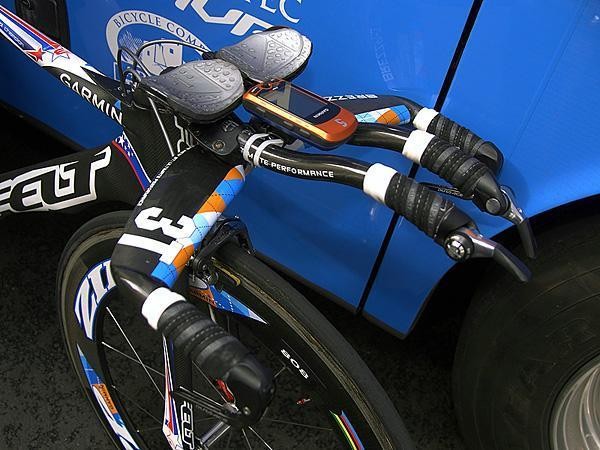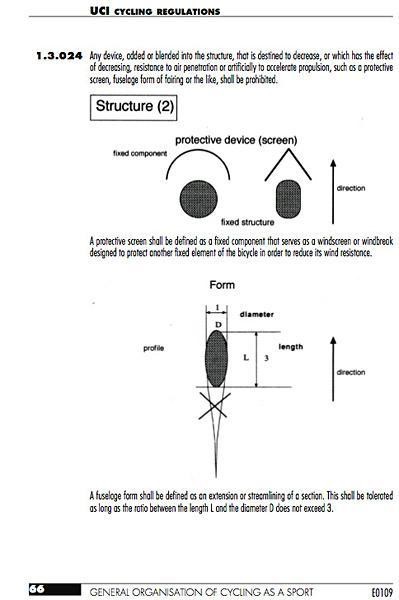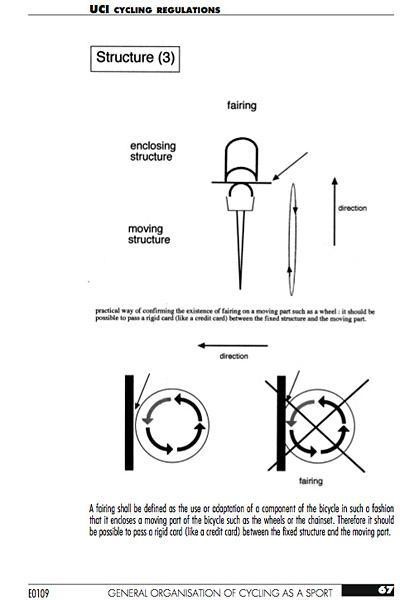A stay of execution for now
Thanks at least in part to petitioning by current International Association of Professional Cycling...



Race tech: Tour of California, February 18, 2009
Thanks at least in part to petitioning by current International Association of Professional Cycling Teams (AIGCP) president - and Garmin-Slipstream directeur sportif - Jonathan Vaughters, riders and teams at the Tour of California have weathered the UCI '3:1' tech rule storm, at least for now.
Though the official statement is still pending from Pat McQuaid later today, word among the teams is that the UCI now would not strictly enforce that clause until 2010 in order to give teams and manufacturers sufficient time to develop and test replacement gear.
According to UCI chief commissare on site Josee Bevard, officials would not be disqualifying riders and equipment based on the updated ruling but rather would only be crafting a report on items that were not in compliance and sending it back to the UCI headquarters in Switzerland - the same as it apparently did during the opening prologue.
Strictly speaking, rule 1.3.024 isn't new as the 8x2.5cm cross-sectional dimensions and 3:1 maximum aspect ratios have long been in place. But the confusion surrounds the updated verbiage, which previously had been thought to only apply to frames.
The new text states that "a fuselage form" must have an aspect ratio no greater than 3:1 but does not explicitly specify what is classified as a ‘fuselage'. Based on written communication sent to teams from the UCI and obtained by Cyclingnews, those restrictions now also apply to ancillary items such as seatposts, aero base bars, and even crankarms, many of which adhere to 8x2.5cm guidelines but not the maximum aspect ratio.
Wheels are subject to their own set of technical rules and are not affected by the update.
Get The Leadout Newsletter
The latest race content, interviews, features, reviews and expert buying guides, direct to your inbox!
While this stay is obviously good news for the riders and teams, other questions remain about how the UCI wields its all-powerful technical ruling authority: how are these rules decided and by whom? How much notice is given to teams and manufacturers before new rules are implemented? How much is open to interpretation?
Rule 1.3.024 was officially modified and put into effect on January 1, 2009 with a letter from UCI technical advisor sent to teams on January 13, just a few weeks prior to the start of the Tour of California and after many teams and manufacturers had already complete expensive product research and development and wind tunnel testing.
Cyclingnews has obtained a copy of said letter, which reads:
Some teams and manufacturers luckily got wind of the impending change months in advance and adjusted their equipment to suit - case in point Giant's radical time trial bike whose bar dimensions were modified as a result - but others were literally scrambling in recent days to develop some sort of contingency plan just in case.
In spite of the rule clarification's far-reaching implications, the UCI is not required to proactively contact affected parties in regards to rule changes. So while the notice can be viewed as being woefully short, the ultimate responsibility in being up to date on current regulations does technically fall with the teams and their sponsors.
Still, Vaughters said that the UCI was decidedly understanding about the difficulty this rule update presented and acted pragmatically and logically in drafting a temporary solution.
"[ProTour director] Alain [Rumpf] and [UCI president] Pat [McQuaid] were super easy to deal with on this and it's not like I had to go through five days of bureaucracy or whatever," said Vaughters to Cyclingnews while en route to join the team in California from Switzerland. "I called Alain and by the next morning he had already presented it to the technical commission and by that afternoon he already had an answer for me.
"Alain stressed to me over and over again that the primary concern is the integrity of the race and the safety of the riders and so messing around with handlebars the day before the time trial obviously destroys the integrity and potentially the safety of the riders. So they definitely had a very correct big picture of the whole thing."
Vaughters also feels that a more open line of communication between manufacturers and the UCI will go a long way towards preventing future complications as well as clarifying what are almost universally decried as frustratingly vague terminology in the rules.
On the positive side, the often open-ended technical guidelines leave manufacturers and teams room for bending the rules but since the ultimate verdict is still determined by the subjective interpretation of those rules by the commissaire on site, companies take a significant risk when doing so.
"A lot of times the rules are written in French and then translated and you can have issues there and sometimes it's just a matter of legalese versus engineeringese and that's one thing we talked about: getting three or four people involved in manufacturing and get them more regular contact with the UCI," he said.
"[The UCI] do want to take feedback and have an interest in it," he continued. "It's just that maybe there hasn't been an active enough effort on the part of the manufacturers to really go to them and want to have an active desire to give them feedback. Because at the end of the day when you're putting forth technical legislation, sometimes they're sort of writing it a little in the dark and I don't think they want to do that but they're trying to put in place very basic rules. But no one is stepping forward and communicating with them to say ‘what about this?' or ‘what about that?'.
As newly elected head of the AIGCP, Vaughters also hoped to rekindle relations between the riders and the UCI. He and McQuaid are scheduled to meet for that purpose either in California during the race or back in Switzerland the first week of March.
"Obviously this whole handlebar thing was a good example of how if you don't let emotion come into it and you just sit down and look at the issue and deal with it in a professional and calm manner you can get the problems to resolved to everyone's liking pretty fast," stressed Vaughters. "So I'm hoping that if we can get the AIGCP and UCI back on the same page that'll certainly be nice after all of the bombs that went off last year."
Curious to see the UCI technical rules yourself? The complete text is available at: http://www.uci.ch/includes/asp/getTarget.asp?type=FILE&id=34033